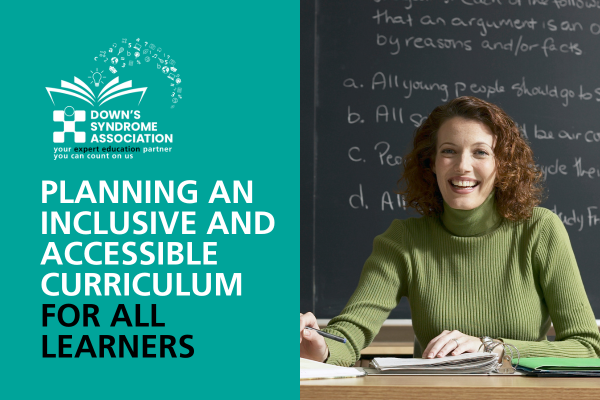Planning an inclusive and accessible curriculum for all learners
Inclusion is about the right of all learners to gain access to the same learning opportunities and curriculum.
Pupils who have Down’s syndrome should follow the same full curriculum and school activities as their typically developing peers, with adaptations as needed. They should spend the majority of the school/college day with their peers in the classroom.
The key is in being proactive in being inclusive in course planning and assessment. It is recognised that some adaptations may be needed for some learners, however the starting point should be the design of a curriculum that is accessible to all. This should help reduce the number of specific interventions or adjustments required for individual pupils, improving the experience for everyone.

Ideally pupils who have Down’s syndrome should only be withdrawn from whole or part of lessons with one to one support to address specific skills that require 1-2-1 delivery, and therapies, eg specific speech and language work. Other areas of targeted support eg reading, writing or social skills are often better undertaken in small groups with peers.
It is therefore important that class/subject teachers take ownership of the inclusion of all learners in the curriculum that they are implementing, and that sufficient planning time is made available to enable this.
Planning your curriculum and lessons
Consider the learning needs of all learners in the classroom and make appropriate accommodations that are available to everybody (eg numicon to be available alongside number-lines, 100 squares etc in a maths lesson, large print resources).
Ensure your lesson planning reflects the differences in all learners’ knowledge and skills. Curriculum mapping should be used for all curriculum areas to identify appropriate content and learning objectives for each topic, within the level that the pupil who has Down’s syndrome is working at. This will also help you see links between different subjects which can help learners make new connections.
Set individual and lesson learning objectives so you are clear on how you hope to extend their learning.
Consider how to build in targets from outreach providers/specialist therapists into the learning objectives for instance speech and language therapy targets.
Be stretching and have high expectations for learners who have Down’s syndrome, but also ensure that the objectives and targets are achievable and that success can be demonstrated.
Ensure that any Learning Support Assistants understand the learning objectives and targets, and how they should support the learner to develop new skills and knowledge. The teacher is responsible for planning the lesson differentiation and adaptations.
In the classroom
Ensure you clearly communicate the learning objectives and any targets to the learner who has Down’s syndrome, so that they are clear on what your expectations are.
Consider what resources will be needed to support all learners in the classroom, including the learner who has Down’s syndrome, and ensure that these are available to everyone at the beginning of the lesson.
Consider supporting the learner who has Down’s syndrome with prelearning topic vocabulary. Work with the family to see if they can help with this at home and whether they can suggest any real-life examples or experiences that will help bring the topic alive for the learner. These links are important for sharing priorities and strategies between home and school.
Foster a culture of collaboration and peer-to-peer support in the classroom. Ensure that the learner who has Down’s syndrome also has opportunities to provide support to their peers and is not always on the receiving end.
Support the learner who has Down’s syndrome to be able to answer questions and to fully engage in classroom discussions.
Consider how tasks and activities can be modelled and rehearsed, as well as what visual resources might need to be prepared to help the learner who has Down’s syndrome to play a meaningful role in the lesson.
Assessment
Provide options for different ways of recording their work based on their learning objectives – for instance if you are testing knowledge of a topic then it is fine to provide a written or verbal answer that demonstrates the topic knowledge, whereas if the learning focus is on improving written prose then the topic can be adapted to be one that the student is more likely to be able to write about.
Assess levels of attainment and measure progress using Performance Levels (P Levels) and National Curriculum levels as appropriate to individual learners and use these alongside individual targets in school reports and Annual Review meetings.
Assessment processes should recognise the achievements of pupils with Down syndrome and be used to inform effective planning for future learning.
When undertaking assessment, consider how you will incorporate specific knowledge of the development of children with Down syndrome, and the individual learner’s specific special educational needs as detailed in their Education, Health and Care Plan.

